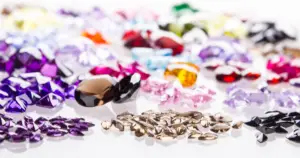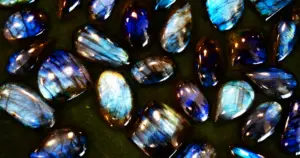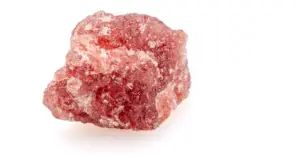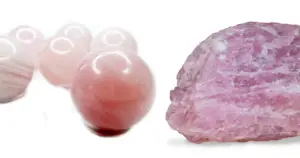How to tell if Carnelian is Real or Fake in 7 Easy Ways
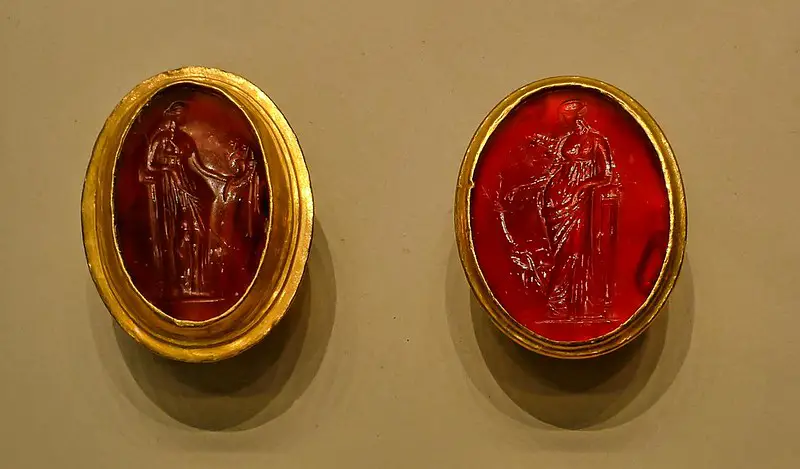
Carnelian is a gemstone with immense historical and metaphysical abundance to offer. It exhibits a few distinct optical and physical properties which you can mobilize to test and explore if a Carnelian is Real or Fake.
The properties include the color, temperature, and hardness of the stone, among other things. For centuries, it has been etched and carved into beads, used in trans-Atlantic trade as currency and jewelry among ancient royalty, from king Tutankhamun’s grave to the historical frescoes of religious places across India, Cambodia, and Sri Lanka.
Here is Beginner-friendly tips in this article to tell apart Real Carnelian from glass and plastic fakes, Sard, and Agate varieties
Typically, Carnelians are widely available and modestly priced, so there is no incentive to sell imitations. But they are often confused with several other similar-looking stones like Agate, Sardonyx, and Sard, which resemble each other too closely to tell apart, especially for beginners.
Suggested reading: Carnelian Crystal Meaning: Healing Properties, Benefits and Uses
Table of Contents
How to Identify if Carnelian is Real or Fake?
Conduct a Hardness Test
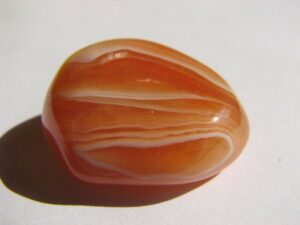
Since Carnelian is a type of cryptocrystalline quartz, its hardness on the Mohs scale is 7. This means that it is sufficiently complex and does not scratch easily. You can test this by scratching the stone with a knife.
- If the knife leaves a scratch mark on your stone, it is likely a fake.
- You can also test hardness by using your stone to scratch glass.
- A real Carnelian will easily scratch glass, while fakes such as dyed glass or plastic won’t.
Observe the kind of Spread of Color
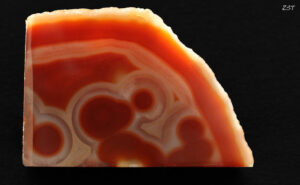
Carnelian is typically translucent to semi-opaque, red, orange-red, or brownish chalcedony. It acquires the color due to the presence of iron oxide.
Almost any chalcedony can be turned orange by heating in an oven since it contains finely disseminated iron compounds oxidized by heating.
A heat-treated silicate sold as Carnelian is hard to distinguish from a naturally occurring one. Sometimes Agates are also heat-treated or dyed and sold as Carnelian.
The central point of difference in coloration between a Carnelian and a heat-treated or dyed Agate will be that a naturally occurring Carnelian will always happen with an even spread of color throughout the stone while Agate occurs with bands of color, arranged either concentrically, in vertical stripes or as cloudy formations.
Read here to Know What does Carnelian Do.
Study the Crystal Structure under Light
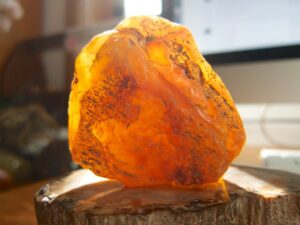
Another way to test if your stone is heat-treated is by holding it under the sun or some other pointed light source like a flashlight.
- When light passes through an Agate, you will be able to see its fibrous structure, which is uncharacteristic for Carnelian.
- Even the more transparent and translucent varieties of Carnelian do not occur with ingrown crystals the way an Agate does.
- Even the most efficiently dyed variety and Agate will hold color only skin deep across its fissures.
- When illuminated from the behind, with a pointed light source like a torch, a dyed agate may show fibers that look like a spider’s web, with fine lines emanating from the rim of the geode to its center.These lines run perpendicular to the agate banding.The pattern is more robust in the periphery and gets weaker as we get to the quartz center of the Agate.
- On the other hand, Real Carnelians not only look evenly colored throughout but also do not look fibrous under the light.
Conduct a Temperature Check
One easy way to tell if your Carnelian is real or fake is to feel its temperature by placing the stone against your cheek. Unlike imitation materials such as glass, plastic, etc., real Carnelian will always feel cold against the skin. You can hold the gemstone in your hand for a while. If it warms to the temperature of your body, it is most likely a fake.
Interested in knowing the incredible benefits of Carnelian, read here.
Run an Acetone Test
You can conduct an acetone test if you suspect that your stone is dyed. Since the presence of iron impurities causes Carnelian’s coloration, the orange of a natural Carnelian is intrinsic to its chemical composition, as opposed to a stone-dyed orange, whose coloration is only skin deep and gives way to surface level chemical reactions.
All you need is your stone, some domestic grade acetone, and a cotton pad for this test.
- Damp a cotton pad in acetone and rub it on your stone for a few minutes.
- If it releases an orange color, then you can be assured that it is artificially dyed.
Look for Inclusions
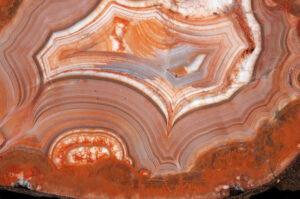
An inclusion, in simple terms, is any kind of material that gets trapped inside another mineral at the time of crystallization.
The size and type of inclusions visible with the naked eye or under magnification tell a lot about the origin and formation and can therefore be used to describe apart fake stones.
For example, a dyed glass crystal synthetically made to look like Carnelian typically carries several minute air bubbles, which can easily be identified by rotating the stone in your palm.
- A Real Carnelian never has any material inclusions that are visible on its surface.
- Those cut from an Agate geode may sometimes show banding.
- Sometimes cheap chalcedony (cryptocrystalline silicate material) is heat-treated and marketed as Carnelian. Such a stone typically has a bulbous formation with several streaks of colors other than orange, as can be seen in the adjacent picture.
- Make sure not to buy these if you are looking for a Carnelian. Such pieces retail for much cheaper than real, raw, uncut Carnelians, so if you gravitate towards such a piece of chalcedony, do not pay an exorbitant price for it.
Observe Luster

Carnelian is often confused with and interchangeably sold as Sard, another darker form of silicon dioxide. However, one tactile way to differentiate between Sard and Carnelian is their respective clusters.
Regardless of whatever polish a stone receives and whatever shape it is cut in, a mineral retains its characteristic luster, i.e., the appearance of the surface of a gemstone when it reflects light. If you find yourself confused by gemological taxonomy, remember that.
- Sard is dense, more intensely colored, typically a deep brown, almost black, and has a waxy or resinous luster.This means that when a piece of Sard reflects light, its surface either looks like it has a thin sheet of wax on it or like resin material (almost resembling a deep colored amber stone)
- Carnelian, on the other hand, shows none of these properties. Real Carnelian is always translucent and has a vitreous (glass-like) luster.
Read here if you want to know the best ways to use Carnelian crystal.
Final Comments
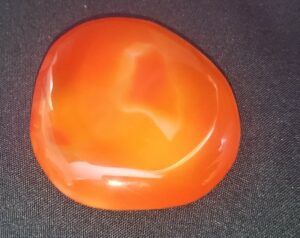
- Buying your stone is the first step of many in establishing a relationship with and establishing it as part of your language. With the metaphysical.
- Most of these call for applying an entire sensorium of sight and tactility in response to the stone’s interaction with light and sometimes with chemicals like acetone.
- Adapting these tools to a digital buying experience is complex and requires that you begin by trusting the merchant you are buying from. But that alone would not do.
- You can request a quality certificate for your Carnelian or ask for video recordings of the stone under light to observe its crystallography, coloration, and luster. This still may not guarantee you receive what you see.
- Another thing you can rely on to suppose the authenticity of your Carnelian is the price it retails for. In the article, we also offered you ways to distinguish between a bulbous heat-treated variety of chalcedony, sometimes marketed as Carnelian. Such silicate material is often cheaply available.
- If you decide to buy one, be sure to know that it is not Carnelian, in the strict sense of the term. Although they are from the same mineral family, and then negotiate a modest price for it.
- Most real Carnelian in the market today comes mainly from Brazil, Uruguay, Egypt, and India. An experienced seller should be able to tell you the source location of the stone you are buying.
- Ensure not to buy Carnelians marketed as mined in America because they are very likely dyed Agate since Agate is abundantly found in Colorado and Arizona.
- Sometimes what may be sold to you as Carnelian could be the orange geode center of an Agate, so you may not be able to the fibers and banding well enough. In that case, make sure to look for the luster and crystal structure of your stone since a real Carnelian, with its trigonal crystal structure, will diffuse light as opposed to an Agate, which will reflect it in bands.
Can Carnelian Go in the Water? Is Carnelian Water Safe? Read here to know.
In this post, we have suggested some of the ways you can identify a real Carnelian apart from a fake and weed off the stone’s misidentification. Kindly share the post to whom you care.
